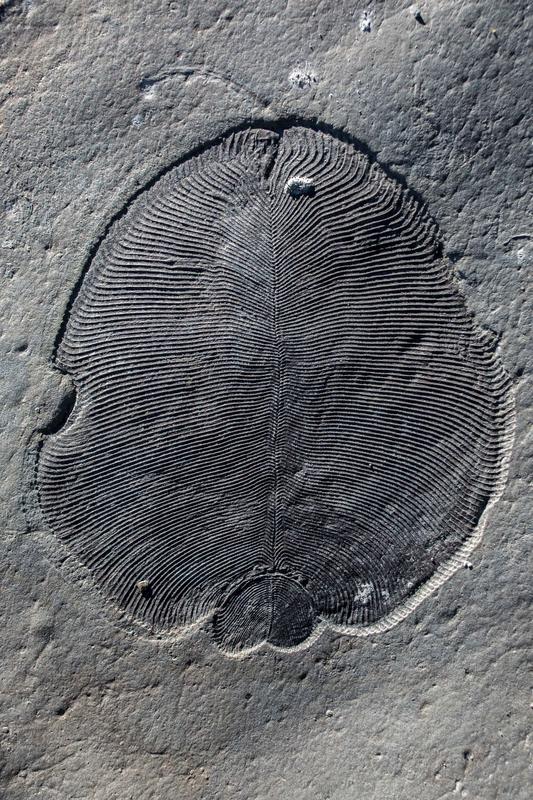558 million-year-old fat reveals earliest known animal

Organically preserved Dickinsonia fossil from the White Sea area of Russia Ilya Bobrovskiy, ANU
The strange creature called Dickinsonia, which grew up to 1.4 metres in length and was oval shaped with rib-like segments running along its body, was part of the Ediacara Biota that lived on Earth 20 million years prior to the ‘Cambrian explosion’ of modern animal life. PhD scholar Ilya Bobrovskiy from The Australian National University (ANU) discovered a Dickinsonia fossil so well preserved in a remote area near the White Sea in the northwest of Russia that the tissue still contained fossil remnants of cholesterol, a type of fat that is the hallmark of animal life.
“The fossil fat molecules that we’ve found prove that animals were large and abundant 558 million years ago, millions of years earlier than previously thought,” said Associate Professor Jochen Brocks, lead senior researcher from the ANU Research School of Earth Sciences.
“Scientists have been fighting for more than 75 years over what Dickinsonia and other bizarre fossils of the Edicaran Biota were: giant single-celled amoeba, lichen, failed experiments of evolution or the earliest animals on Earth. The fossil fat now confirms Dickinsonia as the oldest known fossil belonging to the animal kingdom, solving a decades-old mystery that has been the Holy Grail of palaeontology.”
By analysing fat molecules the team developed a new approach to study Dickinsonia fossils, which hold the key between the old world dominated by bacteria and the world of large animals that emerged 540 million years ago during the ‘Cambrian explosion’. In that era complex animals and other macroscopic organisms – such as molluscs, worms, arthropods and sponges – began to dominate the fossil record.
This is where Christian Hallmann and his team, experts in studies of fossil steroid molecules from the German Max Planck Institute for Biogeochemistry and the University of Bremen came into play. “We had to exclude that Dickinsonia could be protists, single-celled eukaryotes of the lowest organization level, a theory previously followed by others”, postdoctoral researcher Benjamin Nettersheim says.
To this end they systematically studied the lipid composition of various rhizarian protists and artificially aged the biomass of these organisms to make them comparable to the fossils. “The pattern is completely different” says Hallmann, which clearly excludes this old theory.
“The problem that we had to overcome was finding Dickinsonia fossils that retained some organic matter,” said Mr Bobrovskiy from the ANU Research School of Earth Sciences. Most rocks containing these fossils such as those from the Ediacara Hills in Australia have endured a lot of heat, a lot of pressure, and then they were weathered after that.
“Our fossils were located in the middle of cliffs of the White Sea that are 60 to 100 metres high and could only be reached by abseiling”. The unique preservation of Ediacara fossils at this remote locality may hold even far more clues towards the nature of our earliest animal ancestors.
Dr. Christian Hallmann
Max Planck Research Group Leader
Tel: +49 (0)421 218 65 820
challmann[at]bgc-jena.mpg.de
Ilya Bobrovskiy, Janet M. Hope, Andrey Ivantsov, Benjamin J. Nettersheim, Christian Hallmann, Jochen J. Brocks (2018)
Ancient steroids establish the Ediacaran fossil Dickinsonia as one of the earliest animals
Science, Sept 21, published online
https://www.marum.de/wir-ueber-uns/AG-Hallmann.html Website of the Group
Media Contact
All latest news from the category: Earth Sciences
Earth Sciences (also referred to as Geosciences), which deals with basic issues surrounding our planet, plays a vital role in the area of energy and raw materials supply.
Earth Sciences comprises subjects such as geology, geography, geological informatics, paleontology, mineralogy, petrography, crystallography, geophysics, geodesy, glaciology, cartography, photogrammetry, meteorology and seismology, early-warning systems, earthquake research and polar research.
Newest articles

NASA: Mystery of life’s handedness deepens
The mystery of why life uses molecules with specific orientations has deepened with a NASA-funded discovery that RNA — a key molecule thought to have potentially held the instructions for…

What are the effects of historic lithium mining on water quality?
Study reveals low levels of common contaminants but high levels of other elements in waters associated with an abandoned lithium mine. Lithium ore and mining waste from a historic lithium…

Quantum-inspired design boosts efficiency of heat-to-electricity conversion
Rice engineers take unconventional route to improving thermophotovoltaic systems. Researchers at Rice University have found a new way to improve a key element of thermophotovoltaic (TPV) systems, which convert heat…



